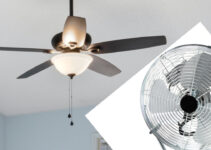In the winter, ceiling fans should rotate clockwise at a low speed to push warm air down from the ceiling. This produces a gentle updraft, forcing the warm air near the ceiling into the occupied space. In the summer, ceiling fans should rotate counterclockwise to pull cool air up from the floor. This produces a downdraft, forcing the cool air near the ceiling into the occupied space.
With the arrival of winter in many parts of the world, now is the time to make sure your ceiling fans are set to rotate clockwise. Doing so will help circulate warm air throughout your home, making it more comfortable during the colder months.
How To Confirm My Ceiling Fan Direction In Winter?
If you want to ensure that your ceiling fan is set for the winter, switch it on and stand underneath it. Look up and watch the blades move. If they are moving like the clock’s hands, then it is set for winter. If the ceiling fan blades move counterclockwise, it is set for summer.
Why Would I Ever Want To Switch On My Fan In The Winter?
That’s what many people don’t understand. Why would ceiling fan companies tell you to do something that seems so contradictory – use a ceiling fan in the winter?
The answer is simple. Physics!
Many people believe that ceiling fans are only for use in the summertime, but this is not the truth. Ceiling fans can be used year-round to help improve your home’s air circulation and actually improve winter heating, no matter what the temperature is outside.
Advantages of Adjusting Ceiling Fan Direction For Winter
When you think about ceiling fans, the first thing that probably comes to mind is a refreshing breeze on a hot day. However, ceiling fans offer much more than just a summertime solution for cooling down. Ceiling fans can:
- Help improve the heating in your home during the winter.
- Be used year-round to improve the quality of air circulation.
- Help reduce energy costs by circulating the warm air that rises to the ceiling.
- Be used in conjunction with your furnace or other heating systems.
- Help to keep the air in your home from becoming stale.

Advantages of Adjusting Ceiling Fan Direction For Summer
While ceiling fans are not typically used as the primary cooling source in most homes, they can supplement your air conditioner and help you save money on your energy bills. In the summer, ceiling fans can:
- Help circulate the cool air from your air conditioner throughout your home.
- Help reduce the time your air conditioner needs to run each day.
- Make your home feel cooler without actually changing the temperature.
- Provide a refreshing breeze on a hot day.
- Help reduce the time your air conditioner needs to run each day.
How Can I Adjust My Ceiling Fan’s Direction For Winter?
Most ceiling fans are designed so that they can be used in both the winter and the summer. By changing the direction of the blades, you can take advantage of the benefits that ceiling fans offer year-round.

Depending on the model of your ceiling fan, there may be a switch on the side of the motor housing that allows you to change the direction of the blades. Many newer models have options on the remote control or smartphone app that will enable you to change the ceiling fan direction. Once you have confirmed which direction your ceiling fan should be rotating, flip the switch so that it will rotate clockwise when turned on.
Consult your ceiling fan’s manual for more information on how to change the direction of your particular model.
Manually Changing Your Ceiling Fan Direction For Winter
If your ceiling fan does not have a switch, then you will need to adjust the blades manually. To do this, turn off the power to the ceiling fan at the breaker box and carefully remove the blades from the motor housing. Once the blades are removed, flip them over and reattach them to the motor housing. Be sure to check the manufacturer’s instructions for your specific model of ceiling fan before changing the blade direction.
Why DC Ceiling Fans Are More Preferred For Winter and Summer
The main reason that DC ceiling fans are preferred is that they use up to 70% less energy than traditional AC ceiling fans. This can save you significant money on your energy bills, especially if you use your ceiling fan year-round.
DC ceiling fans also have more speed settings as compared to AC ceiling fans. This means that you can set your fan on the slowest speed in winter, just enough to circulate the warm air without making it too windy in the room. This will ensure optimum comfort for you and your family while keeping the temperatures in the perfect range.
In summer, you can set the ceiling fan speed to a higher setting to enjoy a refreshing breeze.
In addition, DC ceiling fans are designed to run more quietly and smoothly than AC ceiling fans so that you can enjoy the benefits of a ceiling fan without the noise.
Conclusion – Ceiling Fan Clockwise or Counterclockwise in Winter
So, ceiling fan clockwise or counterclockwise in winter? Clockwise is the preferred direction for a ceiling fan to move in winter. This is because clockwise rotation creates an updraft, pushing warm air near the ceiling into the occupied space. This can help to circulate the warmth.
FAQs
Which is the best ceiling fan winter mode?
The best mode for your ceiling fan to be operating on in winter is “slow” with “clockwise rotation”. If you want to change the setting of your ceiling fan for winter, most models will have a switch on the side of the motor housing that you can toggle. You may also be able to do this with a remote control or smartphone app if your model is newer.
What is the ceiling fan winter vs summer difference?
The main difference between ceiling fan winter and summer modes is the direction that the blades are spinning. Ceiling fans should rotate clockwise in winter to create an updraft and push warm air down into the room. In the summer, ceiling fans should rotate counterclockwise to create a downdraft and cool the room. Ceiling fans should also be set to slower speeds in winter and higher speeds in summer.
How to ensure that my ceiling fan winter setting is correct?
To ensure that your ceiling fan is set correctly for winter, you should check the manufacturer’s instructions for your specific model. Many models will have a switch on the side of the motor housing that you can toggle to change the direction of the blades. You may also be able to do this with a remote control or smartphone app if your model is newer. If your model is not an advanced one, you will have to change the direction manually by removing the blades and attaching them in reverse order. Ceiling fans should always rotate clockwise in winter to create an updraft and push warm air down into the room.
Which is the preferred ceiling fan winter rotation?
The preferred ceiling fan winter rotation is clockwise. This is because clockwise rotation creates an updraft, which pushes warm air near the ceiling down into the occupied space. This will help to circulate the warmth. Ceiling fans should always be set to slower speeds in winter to avoid creating a wind chill effect.
Which is the best winter ceiling fan speed?
The best winter ceiling fan speed is “slow”. Ceiling fans should always be set to slower speeds in winter to avoid creating a wind chill effect. Slow speeds will still circulate the air and push warm air down into the room without making it too windy.
Winter ceiling fan should turn in which direction?
Winter ceiling fans should always rotate clockwise to create an updraft and push warm air down into the room. Ceiling fans should be set to slower speeds in winter to avoid creating a wind chill effect.






No Responses